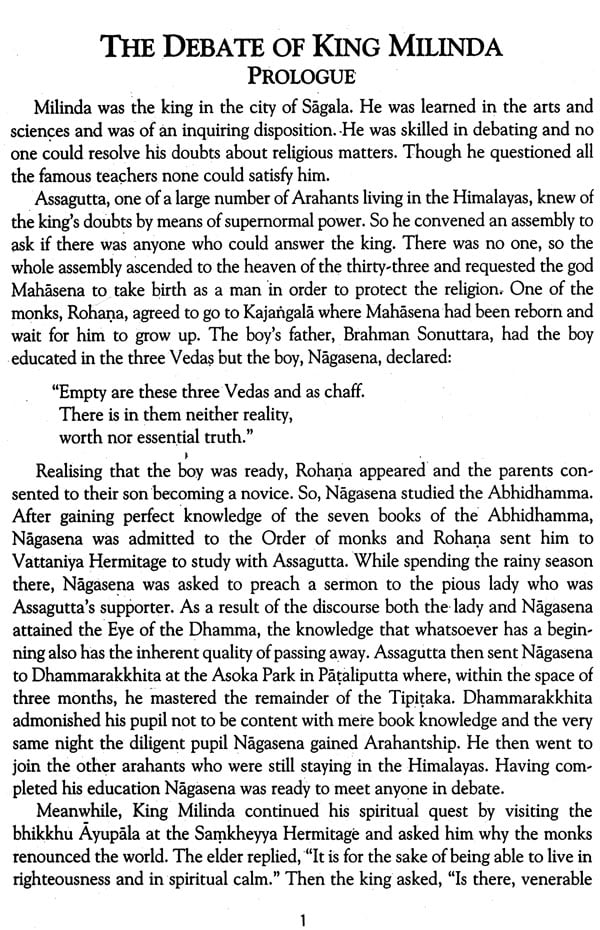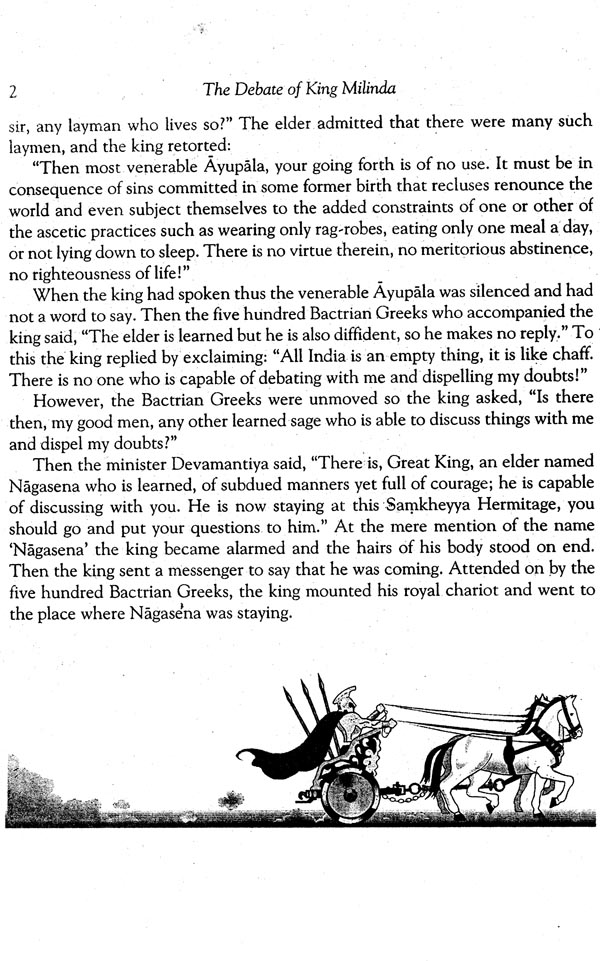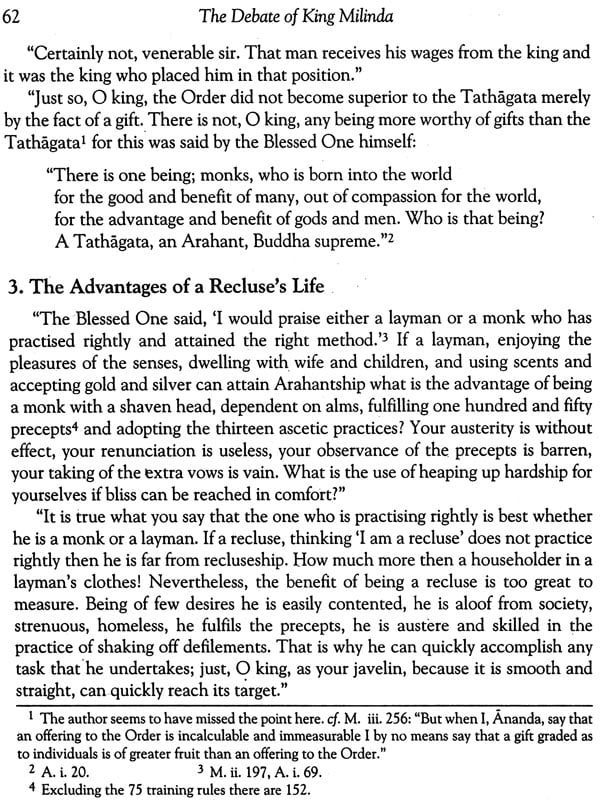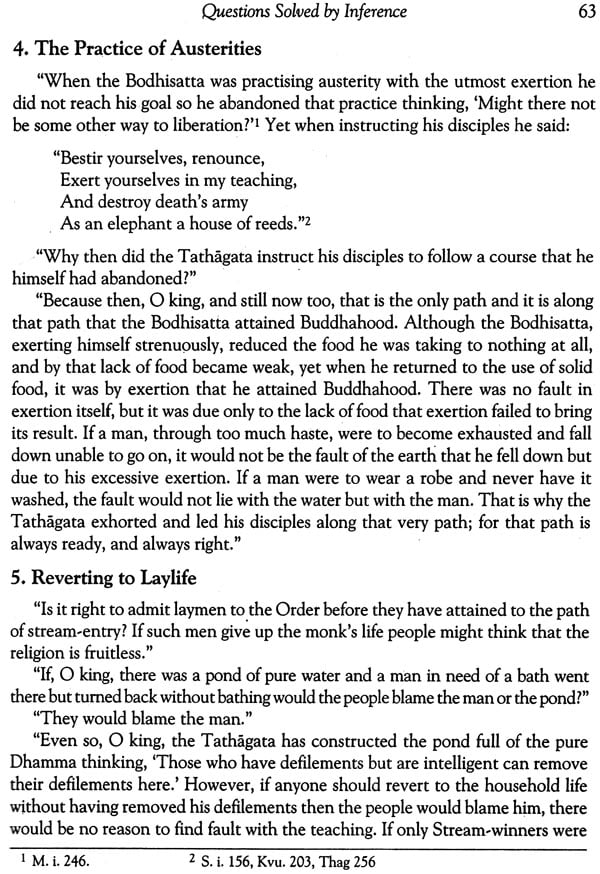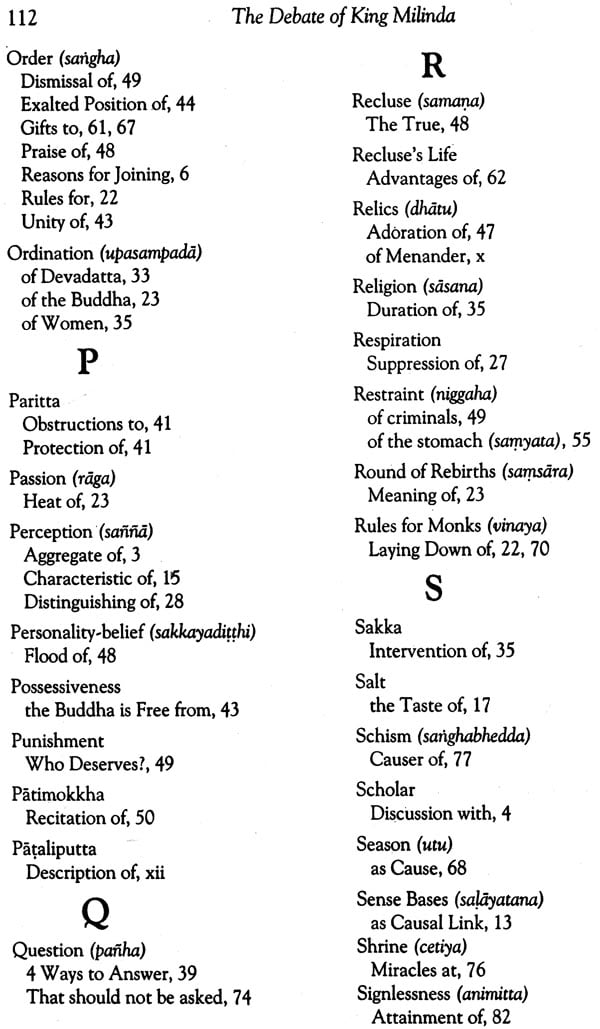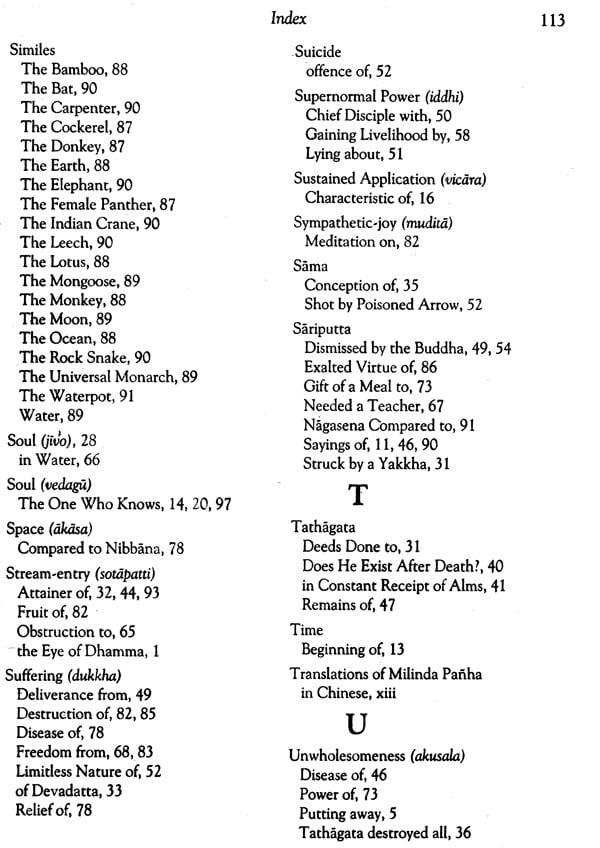
The Debate of King Milinda
Book Specification
| Item Code: | IDC173 |
| Author: | BHIKKHU PESALA |
| Publisher: | Motilal Banarsidass Publishers Pvt. Ltd. |
| Language: | English |
| Edition: | 2009 |
| ISBN: | 9788120808935 |
| Pages: | 156 |
| Cover: | Hardcover |
| Other Details | 8.9" X 5.7" |
| Weight | 320 gm |
Book Description
The Milinda Pariha is, with good reason, a famous work of Buddhist literature, probably compiled in the first century B.C. It presents Buddhist doctrine in a very attractive and memorable form as a dialogue between a Bactrian Greek King, Milinda, who plays the 'Devil's Advocate' and a Buddhist sage, Nagasena. The topics covered include most of those questions commonly asked by Westerners such as "If there is no soul, what is it that is reborn?" and "If there is no soul, who is talking to you now?"
This abridgement provides a concise presentation of this masterpiece of Buddhist literature. The introduction outlines the historical background against which the dialogues took place, indicating the meeting of two great cultures - that of ancient Greece and the Buddhism of the Indus valley which was a legacy of the great Emperor Asoka. It is hoped that the adequate references, glossary, index and list of references, glossary, index and list of Pali quotations will provide readers with an incentive to read further from the translations of the Pali texts.
About the Author:
Bhikkhu Pesala is an English monk ordained in 1979 by Venerable Mahasi Sayadaw of Burma while the Venerable Sayadaw was on a mission to the United Kingdom to teach Vipassana Meditation.
Bhikkhu Pesala has visited Burma three times to train in Mahasi Sayadaw's Vipassana method.
After returning to the UK in 1985 he worked closely with Venerable Hammalawa Saddhatissa, helping him to prepare a number of publications including:
- 'A Buddhist Manual',
'Abhidhammatthavibhavini-tika',
'Pali Literature of South-East Asia'
and 'Facets of Buddhism'
The Milinda Pamha is a Pali Book written in about the 1st century B.C. King Milinda a Bactrian king who ruled the northeast of India met a learned monk called Nagasena and the king put a number of questions on the philosophy psychology and ethics of Buddhism I presume this debate was conducted in the Bactrian greek language but was later translated into Palin and Sanskrit.
This well known Pali book called Milinda Pamha or question of king Milinda has twice been translated into English in 1890 and in 1969. both translations are literary and in many places literal therefore they were mainly confined to scholars. This present work is however not a literal but a free rendering making an abridgement and aimed at the reader who prefers to take a short cut rather than the long way not notwithstanding that the latter may be very beautiful.
The framework remains the same as the original but in many cases the number of similes used to make point has been reduced.
The author Bhikku pesala is a Buddhist monk who had training in Burma and Thailand whose knowledge of Pali has enabled him to check areas of ambiguous translation to compile this concise and readable work in elegant modern English while his knowledge of Buddhism has enabled him to clarify some obscure ideas.
This book will certainly serve its intended aim by the uncomplicated presentation of the original work.
The Milinda Pañha is an ancient and much venerated book of the Buddhists, indeed regarded so highly as to be included by the Burmese in the Pall Canon. In the Pali book it says that the conversations between King Milinda and Nagasena took place five hundred years after the Parinibbana of the Buddha. Mr. T.W. Rhys Davids, the most able translator of the Pali texts) regarded the Milinda Panha very highly. He said, j venture to think that the Questions of King Milinda’ is undoubtedly the masterpiece of Indian prose; and indeed the best book of its class, from a literary point of view, that had been produced in any country.
The style of the Milinda Pañha is very much like a Platonic dialogue) Nagasena playing the part of Socrates and winning over King Milinda to the Buddhist view point by his sound reasoning and his fitting similes. The author is not known but it is almost certain that he lived in the far northwest of India or in the Punjab, since he mentions no place in the interior of India south of the Ganges.2 This is supported by what is definitely known about King Menander, a Bactrian king identified with Milinda.
Much more is known about King Menander. Many of his coins have been found over a wide area of northern India, as far west as Kabul, as far east as Mathura and as far north as Kashmir. The portrait is sometimes of a young man and other times that of a very old man. Plutarch says, “Menander was a king noted for justice who enjoyed such popularity with his subjects that upon his death, which took place in camp, diverse cities contended for the possession of his ashes. The dispute was settled by the representatives of the different cities agreeing to divide the relics, and then erecting separate monuments to his memory”
The recent publication of the Mir Zakah treasure confirms the rule of Menander in Ghazni and adjoining areas of the Kabul valley in the north (there are 521 coins of Menander in that treasure). The discovery of an Attic Tetradrachm of Menander sets speculation at rest; he must have ruled over the Kabul region. In the north he occupied Hazara and the Swat valley.2 So Menander was one of the most important of those Greek kings who continued in Bactria the dominion founded by Alexander the Great. He probably reigned from about 150 to 10 B.C. (thus dating his conversations not much more than 400 years after the Parinibbana of the Buddha). Strabo, draws attention in passing to the remarkable way in which the kingdom of Bactria expanded beyond its original limits, and he mentions incidentally that the kings chiefly responsible were Demetrius and Menander ... But Menander left a far deeper mark on the tradition of India than did Demetrius.
Menander annexed the Indus delta, the peninsula of Surastra (Kathiavar), occupied Mathura on the Jumna, besieged Madyamika (Nagari near Chitor) and Saketam in southern Oudh, arid threatened the capital, Patahputta. But the invasion was repulsed and Menander was forced to return to his own country. Since the Bactrians later became Buddhists there can be little doubt that King Menander is indeed the King Milinda referred to in the book. However, the conversations may be just a literary device-the author used to add interest, His primary aim is to clarify Buddhist doctrine and to refute the wrong views promulgated by various opponents of Buddhism.
The introductory story in the Milinda Panha concerning Nagasena’s upbringing is almost identical to the story of the young Moggaliputta Tissa, which is told in the Mahavamsa, the Ceylon Chronicles. Moggaliputta Tissa Thera lived about a hundred years before Menander and is mentioned twice in the text [Miln. pp 3,71] so it is probably his story that is the older of the two. However, the Mahãvamsa was written much later, by Mahãnãma at the beginning of the 6th century AD., so the story could have been borrowed by Mahãnama from the Milinda Pañha, which was by then a venerable book edited by Buddhaghosa. (In the Milinda Tika, a commentary on the Milinda Panha, it is stated that several verses of prologue and epilogue in the Milinda Pañha were composed by Buddhaghosa).
From the supposed conversation that Milinda has with Purana Kassapa, Makkhali Gosala and other ascetics3 it is obvious that this introductory story was fabricated by the author since these ascetics were contemporaries of the Buddha. The story is based on the Samanña Phala Sutta of the Digha Nikaya. One point of difference is noteworthy: in the Sãmanna Phala Sutta,4 Prince Ajatasattu goes to see the Buddha but is unable to recognize him; whereas in the introduction to the Milinda Panha, King Milinda says of Nagasena, There is no need to point him out to me,” thus showing his great superiority to Prince Ajatasattu.
The Rise of the Magadha Kingdom
in the Mahaparinibbana Sutta the Buddha predicted that the city of Pataliputta, which was founded shortly before his death, would become a great city, “Ananda, among the towns and cities that are centres of congregation and commerce of people of the Aryan race, this new town will become the greatest city called Pataliputta, a place where goods are unpacked, sold and distributed, but it will be in danger from flood, fire and internal I The Magadha Kingdom, of which Pataliputta (modern Patna) was the capital, gradually became the most powerful in all India.
In the mid 4th century B.C. a Sudra named Mahapadma Nanda usurped the throne of the kingdom of Magadha and became the ruler of a kingdom stretching from the Brahmaputra river in the east to the Beas in the west. But beyond the Beas were several small kingdoms.
During this period, Alexander the Great conquered Persia and crossed the Hindu Kush into Bactria (Northern Afghanistan). It took him two years to subdue these inhospitable regions, but in so doing he founded several cities penetrating as far north as Samarkand and Leninabad (in the USSR). Another city has been identified at Charikar (north of Kabul). Hearing about the rivet Indus he recrossed the Hindu Kush in 327 B.C. and pushed eastwards to Taxila (Taklcasila), but when he reached the) helum river he encountered the Paurava rajah who had war elephants. Even the veterans of Macadonia were unable to continue against such opposition so Alexander was forced to retreat down the Indus river and thence back through Persia, where he died at Babylon in 323 B.C. Nevertheless, he had left behind him the foundations of the Bactrian kingdom and had surveyed the Jhelum and Indus rivers.
After Alexander’s death, Chandragupta, the founder of the Mauryan dynasty, was able to drive away the Greek garrisons from the Indus valley. In 321 B.C. he defeated Nanda and became the ruler of the Magadha kingdom from the capital at Pãlalipurta. Alexander’s successor, Seleukos 1 Nikator, led an expedition against the Indians in 311 B.C. hoping to regain the Punjab. However, he was up against the might of Chandragupta. So, by 304 B.C., Seleukos was glad to conclude a treaty with him, giving his daughter in marriage and ceding large areas of what is now Baluchistan and Afghanistan in exchange for 500 war elephants. Seleukos sent his ambassador, Magasthenes, to Pataliputta and from what remains of his writings we know something about the size of the army and the strength of the fortifications there. Chandragupta ruled for 24 years and his son Bindusra, about whom we know very little, ruled for 28 years until his death in 269 B.C.
At the time of Bindusara’s death his eldest son was the viceroy at Takkasila and his younger son, Asoka, was the viceroy at Ujjeni in the south. Asoka fought with his brother for the right to ascend to the throne, and when his brother was killed in battle, Asoka became the ruler of a vast empire from Bengal to Afghanistan. However, he was still not satisfied and it was only in the ninth year of his reign, after the bloody conquest of the Kalinga kingdom (Orissa) that he gave up warfare and became a devoted follower of Buddhism. Emperor Asoka sent missions of monks to the border areas of his great empire. Asokan inscriptions have been found in the Kabul valley written in Greek and Aramaic, and elsewhere his inscriptions say that he had made Dhamma conquests in Egypt, Syria, Macedonia, Greece, Cyprus, Bactria, Kashmir, Gandhãra, etc. The Mahavarnsa says that missionaries were sent to Kashmir, Gandhãra, Bactria, the Himalayas, Sindh (Gujarat), and inscriptions on relic caskets found in stupas at Sanchi record the success of those missions to the Himalayas. Unfortunately, the other stüpa records have been vandalised, but we can be sure that the missions to Kashmir and Gandhãra were successful since even in the Buddha’s time Takkasila was a renowned centre of learning. The Mahavarnsa also records that at the consecration of the Great Stupa in 157 B.C. monks came from Alasanda (Charika) in Yona (Bactria).
The Rise of the Bactrian Kingdom
After the death of Asoka in 227 B.C. the Mauryan empire began to disintegrate. The empire founded by Seleukos had already revolted in 250 B.C. under its governor, Diodotus I and it continued to grow under his successors, Diodotus II and Euthydemus. At the beginning of the 2nd century B.C. the Greek rulers of the new kingdom of Bactria crossed the Hindu Kush and began to invade India from the northwest. Of the Greek kings who ruled to the south of the Kush, Apollodotus would seem to be the first. He is twice mentioned in association with Menander. Their rule extended on the south west to Ariana (southern Afghanistan) and in the south to the Indus valley.
As mentioned above, Menander must have ruled over the Kabul and Swat valleys and at some time he annexed the Indus valley too. Sagala, the city mentioned in the Milinda Paflha as the place where the dialogues took place, was the ancient city of the Madras who came to the region in about the 6th century B.C. It is now Sialkot between the Chenab and Ravi rivers, near the border of Kashmir. At Miln. p.83 (see Questions, page 26) it is mentioned that Kashmir is 12 yojanas (84 miles) distant and that Milinda’s birth place on the island of Alasanda is 200 yojanas away. There are many cities founded by Alexander during his conquests several of which might have been the birth place of Menander. The city founded at Charikar has been suggested by A.K. Narain but it is rather less than 200 yajanas (1400 miles) at the usual reckoning. Could it perhaps be the Alexandra located at Leninabad or one of the Alexandra’s further west?
| Foreword by Series Editor | v | |
| Foreword | vii | |
| Editor’s Preface | ix | |
| Milinda’s India | xvi | |
| Introduction | xvii | |
| The Rise of the Magadha Kingdom | xix | |
| The Rise of the Bactrian Kingdom | xx | |
| Comparison with the Chinese text | xxi | |
| The Arrangement of the Pali book | xxiii | |
| Abbreviations | xxiv | |
| The Debate of King Milinda | ||
| Prologue | 1 | |
| The Great Chapter | ||
| A question of Concepts | 3 | |
| The Long Journey | ||
| Continuity of Dhamma | 10 | |
| Sustained Application | ||
| Beginning the journey | 13 | |
| Nibbana | ||
| Separation of Phenomena | 17 | |
| The Buddha | ||
| Did the Buddha Exist? | 20 | |
| Mindfulness | ||
| Attachment to the body | 22 | |
| Mentality is hard to Discern | ||
| Memory | 25 | |
| The Resolution of Paradoxes | ||
| Preliminary discussion | 29 | |
| 1 | On Honors paid to the Buddha | 30 |
| 2 | The Omniscience of the Buddha | 31 |
| 3 | Devadatta’s ordination | 33 |
| 4 | Causes of earthquakes | 33 |
| 5 | Asseveration of truth | 34 |
| 6 | The Paradox of conception | 35 |
| 7 | The Duration of the Religion | 35 |
| 8 | Purity of the Buddha | 36 |
| 9 | Perfection of the Buddha | 37 |
| 10 | Equanimity of the Buddha | 38 |
| The Schism Chapter | ||
| 11 | The Minor and lesser precepts | 39 |
| 12 | The Esoteric teaching | 39 |
| 13 | The Fear of death | 40 |
| 14 | Protection from death | 41 |
| 15 | The power of Mara | 41 |
| 16 | Knowledge of wrong doing | 42 |
| 17 | The Buddha is not possessive | 42 |
| 18 | The Unity of the order | 43 |
| The Dismissal Chapter | ||
| 19 | Dhamma is best | 44 |
| 20 | The compassion of the Buddha | 44 |
| 21 | The modesty of the Buddha | 45 |
| 22 | The Buddha’s perfect speech | 46 |
| 23 | The Talking tree | 46 |
| 24 | The last meal | 47 |
| 25 | Adoration of Relics | 47 |
| 26 | The Buddha’s foot is injured | 48 |
| 27 | The true recluse | 48 |
| 28 | The Boasting of the Buddha | 48 |
| 29 | Who deserves Punishment? | 49 |
| 30 | Dismissal of the order | 49 |
| The Omniscience Chapter | ||
| 31 | The Murder of Moggallana | 50 |
| 32 | Secrecy of the Vinaya | 50 |
| 33 | Intentional lying | 51 |
| 34 | Investigations of the Bodhisatta | 51 |
| 35 | On Suicide | 52 |
| 36 | Protection by loving kindness | 52 |
| 37 | Why did devadatta prosper? | 53 |
| 38 | The Weakness of women | 53 |
| 39 | Venerable Ananda’s courage | 54 |
| 40 | The Buddha’s change of heart | 54 |
| The Dwelling place chapter | ||
| 41 | On Dwelling places | 55 |
| 42 | Restraint of the stomach | 55 |
| 43 | The Best of Men | 56 |
| 44 | The Ancient path | 56 |
| 45 | The Bodhisatta’s weakness | 57 |
| 46 | Respect for the robe | 57 |
| 47 | The Merit of the potter | 58 |
| 48 | King or Brahman? | 58 |
| 49 | Right Livelihood | 59 |
| 50 | The Reluctance of the Buddha | 59 |
| 51 | The Buddha’s teachers | 60 |
| Questions solved by Inference | ||
| 1 | Two Buddhas Cannot exist together | 61 |
| 2 | Gifts to the order | 61 |
| 3 | The Advantages of a Recluse’s life | 62 |
| 4 | The Practice of Austerities | 63 |
| 5 | Reverting to Laylife | 63 |
| 6 | The mastery of the arahants | 64 |
| 7 | Heinous crimes | 65 |
| 8 | The Unvirtuous | 65 |
| 9 | Is water alive? | 66 |
| The Impediments Chapter | ||
| 10 | Be Without impediments | 67 |
| 11 | The Lay Arahant | 67 |
| 12 | The Offences of Arahants | 67 |
| 13 | What is not found in the world | 68 |
| 14 | The uncaused | 68 |
| 15 | Modes of production | 69 |
| 16 | Demons | 69 |
| 17 | Laying down of rules for monks | 70 |
| 18 | The Heat of the sun | 70 |
| 19 | The winter Sun | 70 |
| The Vessantara Chapter | ||
| 20 | The Gift of Vessantara | 71 |
| 21 | Austerities | 72 |
| 22 | The power of Evil | 73 |
| 23 | Sharing of Merit | 74 |
| 24 | Dreams | 75 |
| 25 | Premature Death | 76 |
| 26 | Miracles at shrines of Arahants | 76 |
| 27 | Cam everyone understand the Dhamma?? | 77 |
| 28 | The Bliss of Nibbana | 77 |
| 29 | Description of Nibbana | 78 |
| 30 | The Realisation of Nibbana | 79 |
| 31 | where is Nibbana | 80 |
| The Inference Chapter | ||
| 32 | A Question solved by inference | 81 |
| 33 | The Ascetic practices | 84 |
| The Similes | ||
| 1 | The Donkey | 87 |
| 2 | The Cockerel | 87 |
| 4 | The female panther | 87 |
| 7 | The Bamboo | 88 |
| 10 | The Monkey | 88 |
| 12 | The Lotus | 88 |
| 20 | The Ocean | 88 |
| 21 | The Eartj | 88 |
| 22 | Water | 89 |
| 27 | The moon | 89 |
| 30 | The Universal Monarch | 89 |
| 35 | The Mongoose | 89 |
| 40 | The Elephant | 90 |
| 46 | The Indian crane | 90 |
| 47 | The Bat | 90 |
| 48 | The Leech | 90 |
| 50 | The Rock Snake | 90 |
| 60 | The Carpenter | 90 |
| 61 | The waterpot | 91 |
| Bibliography | ’2 | |
| Glossary | 93 | |
| Quotations | 98 | |
| Index | 107 |
